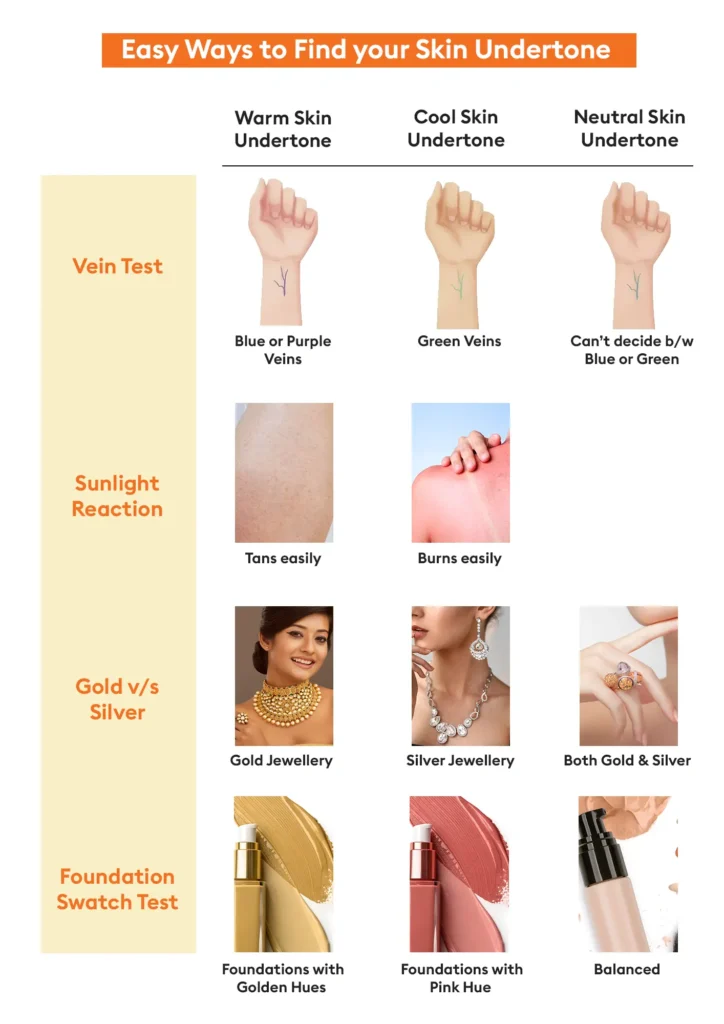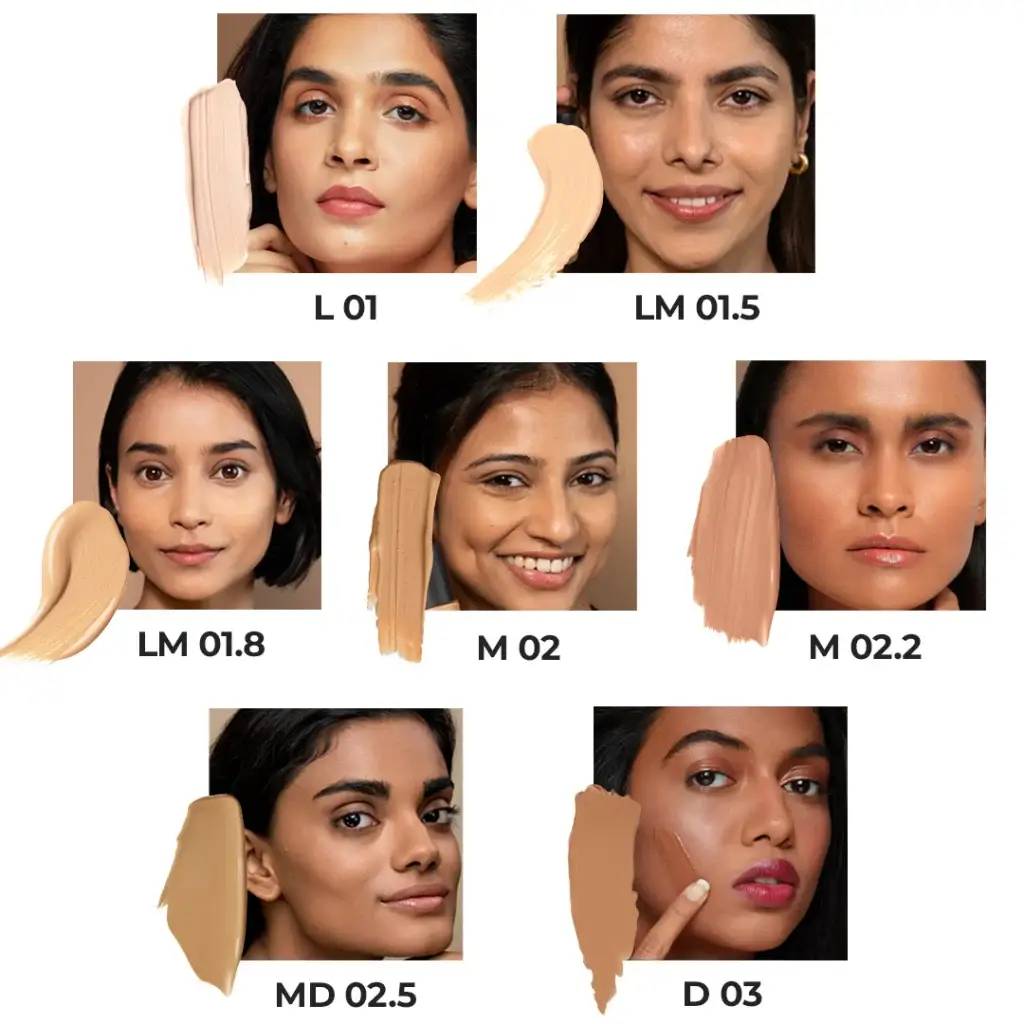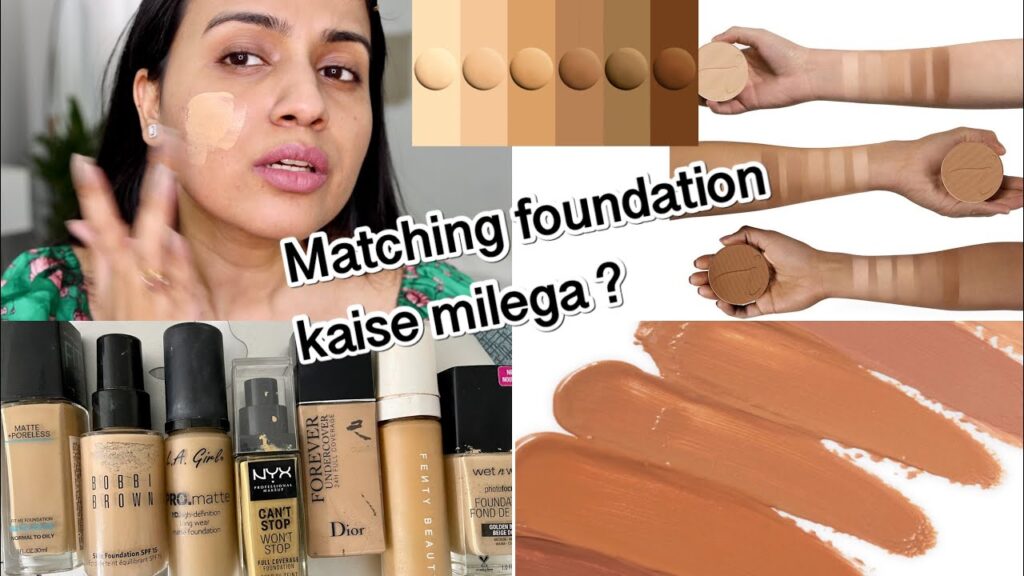Finding the perfect foundation can feel like searching for a needle in a haystack. With endless options—liquid, cream, powder, matte, dewy, full-coverage, lightweight—how do you know which one is right for your unique skin tone?
If you’ve ever looked in the mirror and thought, “Why does my foundation look too ashy, too orange, or just… off?” — you’re not alone. The secret lies not just in skin color but in understanding undertones, lighting, texture, and more.
This guide will walk you through everything you need to know to choose the right foundation for your skin tone, so you’ll never make a mismatched makeup mistake again.
Know Your Skin Tone

What is Skin Tone?
Your skin tone is the natural color of your skin’s surface. It generally falls into one of the following categories:
Fair – Very light skin, often burns easily
Light – Slightly warmer than fair
Medium – A popular category, often with olive or golden tones
Tan – A sun-kissed appearance; deeper than medium
Deep – Rich and darker skin tones
How to Identify Your Skin Tone
Look at your bare skin in natural light (near a window, without any makeup):
Does it look pale, light, golden, or deep?
Compare your skin to others you know, or use online charts for reference.
Tip: The inside of your wrist or jawline is a good area to test foundation and check your tone.
Understand Your Skin Undertone
What is an Undertone?
While your skin tone is about how light or dark your skin is, your undertone is the subtle hue underneath that tone. It doesn’t change with sun exposure.
Types of Undertones
Cool: Hints of blue, red, or pink
Warm: Hints of yellow, golden, or peach
Neutral: A balance of warm and cool tones
How to Determine Your Undertone
Here are a few quick tests:
a) Vein Test
Look at the veins on your inner wrist:
Blue or purple = Cool
Green = Warm
Both = Neutral
b) Jewelry Test
Silver jewelry flatters cool undertones
Gold jewelry flatters warm undertones
Both look good = neutral
c) White Paper Test
Hold a white paper next to your bare face:
Skin looks rosy/pink = Cool
Skin looks yellow/golden = Warm
Can’t decide = Neutral
Know Your Skin Type
Even the right color foundation can look bad if it’s not suitable for your skin type.
Oily Skin: Choose oil-free, matte, or powder foundations
Dry Skin: Go for hydrating, dewy, or liquid foundations
Combination Skin: Stick to satin or semi-matte foundations
Sensitive Skin: Look for fragrance-free, dermatologist-tested formulas
Acne-Prone Skin: Use non-comedogenic products with breathable formulas
Swatch Test Like a Pro
Where to Test Foundation
Always test foundation on your jawline or neck, not your wrist or hand. This gives a more accurate color match.
How to Test
Swatch 2–3 shades side by side.
Blend them slightly.
The one that “disappears” into your skin is your match.
Check in natural light, not just store lighting.
Consider Seasonal Changes
Your skin tone can change with the seasons.
Summer: Slightly deeper/tanned
Winter: Paler and cooler
Pro Tip: Keep two foundation shades (summer and winter) and mix them during transition months like spring and fall.
Choose the Right Foundation Formula

a) Liquid Foundation
Best for most skin types; comes in matte, satin, or dewy finishes.
b) Powder Foundation
Good for oily skin; gives a matte finish and is easy to apply.
c) Cream Foundation
Ideal for dry or mature skin; offers full coverage and hydration.
d) Stick Foundation
Great for quick applications or travel. Offers good coverage and is buildable.
Foundation Finish Matters
Matte: Flat, shine-free look; good for oily skin
Dewy: Moisturized, radiant look; good for dry skin
Natural/Satin: A balance between matte and dewy; suits most skin types
Don’t Forget About Oxidation
Foundations can oxidize after application—meaning they might get darker or turn orange after mixing with your skin’s oils.
Solution:
Wait 10–15 minutes after swatching before buying. Choose a shade slightly lighter if oxidation is a problem.
Take Advantage of Technology
In 2025, AI and AR have revolutionized makeup shopping.
Try Virtual Tools
Use apps from brands like:
L’Oréal’s ModiFace
Sephora’s Virtual Artist
Nykaa’s Try-On Tool (India-specific)
These tools use AI to scan your face and suggest foundation matches.
Foundation Matching for Indian Skin Tones

Common Indian Undertones
Most Indian skin tones have warm or neutral undertones with olive, golden, or reddish hues.
Top Shades to Try:
MAC NC40, NC42 (for medium warm tones)
Maybelline Fit Me 310 or 330 (for warm to tan tones)
Huda Beauty in Chai, Dulce de Leche, or Toffee
L.A. Girl in Warm Beige or Caramel
Local Tip: Indian brands like Kay Beauty, Lakme, and Sugar offer ranges specifically formulated for Indian skin tones.
Build Your Custom Blend (Optional but Advanced)
Can’t find the perfect shade? Create your custom blend:
Mix two foundations (light + dark) or (warm + cool)
Add a foundation adjuster for tone correction (blue, yellow, pink adjusters)
Test Before You Invest
If you’re buying a high-end foundation, always request a sample pot or mini version before committing to a full-size bottle.
Bonus Tips for Perfect Application
Use a primer to prep your skin
Apply with a damp beauty sponge or foundation brush
Set with translucent powder if needed
Use a setting spray for long wear
Common Mistakes to Avoid
Buying based on packaging or influencer trends without testing
Ignoring undertones
Testing on hands instead of face
Using only artificial lighting
Not blending foundation into the neck
Conclusion: Confidence Starts with the Right Base
Choosing the right foundation is a mix of science, art, and a little bit of trial and error. Once you understand your skin tone, undertone, and type, you’ll find it much easier to identify your perfect match.
A well-matched foundation doesn’t just make you look good—it boosts your confidence, elevates your makeup look, and gives your skin the flawless finish it deserves.
So go ahead, swatch with confidence, and let your true skin glow shine through.
Related posts:
 10 Everyday Skincare Habits That Will Transform Your Skin
10 Everyday Skincare Habits That Will Transform Your Skin
 Religion and Moral Values: The Foundation of a Harmonious Society
Religion and Moral Values: The Foundation of a Harmonious Society
 How to Remove Holi Colors? Precautions to Take Before Playing Holi
How to Remove Holi Colors? Precautions to Take Before Playing Holi
 Chanakya Neeti: Timeless Wisdom for Modern Life
Chanakya Neeti: Timeless Wisdom for Modern Life
 Unlocking the Secrets of Sleep: How Sleep Physiology Shapes Brain Function
Unlocking the Secrets of Sleep: How Sleep Physiology Shapes Brain Function
 Sacred Forests and Trees: The Spiritual Connection Between Nature and Culture
Sacred Forests and Trees: The Spiritual Connection Between Nature and Culture
